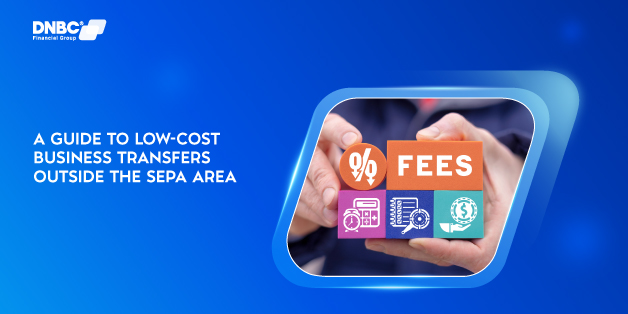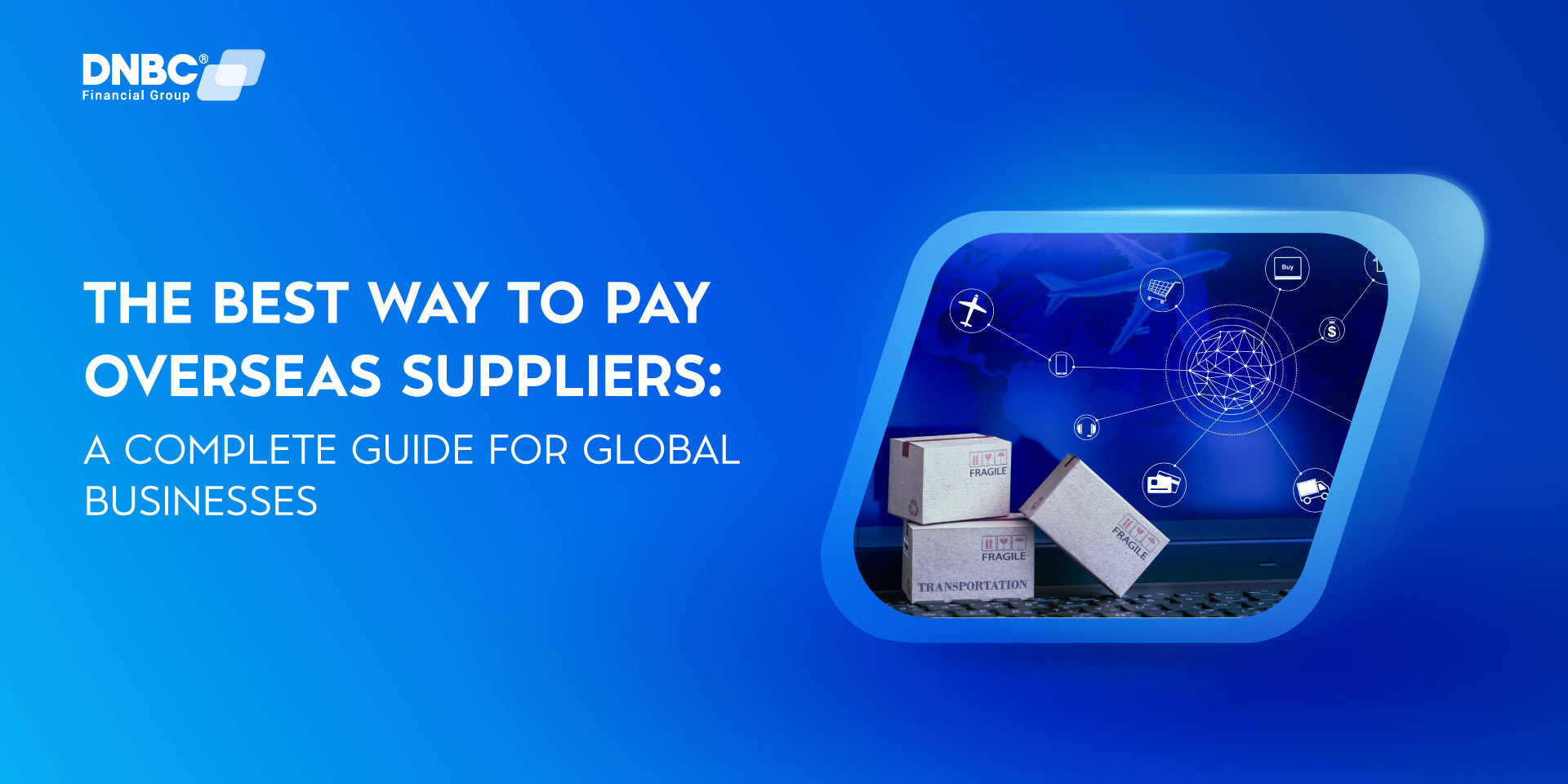- Home
- Blog
- Business Finance
- IBAN Money Transfer: How to Send Funds Easily
IBAN Money Transfer: How to Send Funds Easily
Business Finance
12 February 2025
DNBC Team
This article is a part of DNBCGroup Blog Center
Contact DNBCGroup for the technology news, tips, trends, and updates.
Whether you’re paying for services from a freelancer in another country, covering tuition fees for an international student, or simply wanting to send money with IBAN to friends or family living abroad, international money transfers are necessary in today’s globalized world. However, navigating the world of global banking can quickly become complex. Many people find themselves confused by different account formats and unsure how to guarantee their money arrives securely and on time. Using an IBAN, or International Bank Account Number, is often key to ensuring smoother international transactions. This guide provides a clear, easy-to-follow roadmap to sending money abroad using an IBAN. We’ll cut through the jargon, explain each step simply, and equip you with the knowledge to make international transfers and avoid common pitfalls confidently.
Understanding the Basics: What is an IBAN and Why It Matters?
Navigating international money transfers often involves encountering unfamiliar terms, and IBAN is one you'll see frequently. Let's explain what it means and why it's so important when sending money abroad.
What Exactly is an IBAN?
Think of an IBAN as a unique, super-precise address for a bank account designed specifically for international transactions. IBAN stands for International Bank Account Number. While your regular bank account number works within your own country, an IBAN uniquely identifies an account when you're sending or receiving money across borders, particularly in Europe and increasingly in other parts of the world. It's a standardized system that ensures your money gets to the correct destination, like a postal code, which provides mail that arrives at the proper house in a city but on a global scale for banking. It’s a more extended, detailed version of a standard account number that includes information about the country, bank, and specific account.
Why is an IBAN Crucial for Sending Money Abroad?
Accuracy is paramount When sending money abroad, especially with an IBAN. Using an IBAN significantly reduces the risk of errors and delays that can happen with just a standard account number for international transfers. Without a correct and complete IBAN, your payment might get lost in processing, returned to you, or even worse, in the wrong account! By providing the recipient's IBAN, you're giving the sending bank all the necessary information to route your funds efficiently through the international banking system. In many cases, this speeds up the transfer process and can also minimize costs. While it doesn't guarantee the absence of all fees, using the correct IBAN helps avoid charges arising from routing errors, and manual intervention is often needed when details are incomplete. In short, using an IBAN is the best practice for smooth, accurate, and usually more cost-effective international money transfers.

Step-by-Step Guide: Sending Money Abroad with IBAN
Now that you understand what an IBAN is and why it's vital, let's walk through the exact process of sending money internationally with IBAN. It might seem like many steps, but we'll break it down to make it clear and straightforward.
Your 6-Step Guide to Successfully Send Money with IBAN
Step 1: Get the Recipient's Correct IBAN and Necessary Details.
Before initiating a transfer, the most crucial step is getting the correct information from the person you're sending money to. Mistakes in details, especially the IBAN, are the most significant cause of problems with international transfers. Don't rely on old information or guess – always double-check directly with your recipient to confirm these details are up-to-date.
Here's a checklist of information you'll likely need:
- Recipient's Full Name: Ensure you have their name exactly as it appears on their bank account.
- Recipient's IBAN: This is the most critical piece of information! Ask your recipient to provide it directly from their bank statement, online banking portal, or by contacting their bank. Emphasize that accuracy here is non-negotiable.
- Recipient's Bank Name and Full Address: You'll need the name of their bank and its complete address. This helps identify the correct financial institution.
- SWIFT/BIC Code: Often needed alongside the IBAN, especially for transfers outside of Europe or when sending money abroad IBAN number. The SWIFT (Society for Worldwide Interbank Financial Telecommunication) or BIC (Bank Identifier Code) is a unique code that identifies the recipient's bank internationally. Think of it as the bank's unique international ID. Your recipient should be able to get this from their bank quickly.
- Recipient's Residential Address (Sometimes Required): You might also need the recipient's home address depending on regulations and the amount you're sending.
- Purpose of Payment (Sometimes Required): For some transfers, particularly more considerable sums or to certain countries, you may need to specify the reason for the transfer (e.g., "family support," "payment for services").
You have a few main options for how to send money abroad using an IBAN. The best choice for you will depend on your priorities – speed, cost, convenience, or security.
- Traditional Bank Wire Transfer: This is the classic method. You can initiate an international wire transfer IBAN directly through your bank. You can typically do this by visiting a bank branch or, more commonly now, through your bank's online banking platform. Bank transfers are generally considered secure and reliable, but they can sometimes be more expensive in terms of fees and may offer less favorable exchange rates than other options. Transfer times can also vary, sometimes taking a few business days.
- Online Money Transfer Services: Many online platforms specialize in international money transfers and are often a competitive alternative to traditional banks. Companies like Wise (formerly TransferWise), Remitly, WorldRemit, OFX, and many others offer services designed to make sending money with IBAN abroad cheaper, faster, and more convenient.
- Advantages of Online Services:
- Lower Fees: Online services generally have lower transfer fees than banks, sometimes significantly.
- Better Exchange Rates: They often offer exchange rates closer to the "mid-market" rate (the real exchange rate), reducing the markup compared to banks.
- Faster Transfers: Many online services boast speedier transfer speeds, with some even offering same-day or next-day delivery, depending on the destination and payment method.
- Convenience: Everything is done online – from setting up an account to initiating and tracking your transfer – making it accessible.
- Transparency: Fees and exchange rates are usually clearly displayed upfront before you confirm the transfer.
- How They Work (Simplified): Typically, you create an account with the online service, enter the recipient's details (including their IBAN), specify the amount and currency you want to send, choose a payment method (usually bank transfer or debit/credit card to fund your transfer to them), and then they handle the international transfer to your recipient’s IBAN account.
Once you've chosen your method (bank or online service), you must start the transfer process within their platform.
For Bank Transfers (Online Banking): Log into your bank's online banking portal. Look for options like "International Transfer," "Wire Transfer," or "Foreign Transfer." You will then be guided through a form where you'll input all the recipient details you gathered in Step 1: Name, IBAN, SWIFT/BIC, bank name and address, amount, currency, and potential purpose of payment.For Online Money Transfer Services: Log in to your account on their website or app. Typically, you'll start by selecting "Send Money," "Make a Transfer," or similar. You’ll then follow their prompts to enter recipient details, including name, country, and, then precisely, the IBAN. In most cases, you will also be asked for the SWIFT/BIC code. Input the transfer amount and currency.Step 4: Choose the Currency and Transfer Amount.You must specify the currency you want to send and the exact amount.
- Currency Selection: Make sure you choose the correct currency in the recipient's bank account. Sending in the wrong currency can lead to extra conversion fees for the recipient or even delays.
- Exchange Rates: Pay attention to the exchange rate offered by your bank or the online service. Exchange rates constantly fluctuate, and your rate will affect how much the recipient receives in their local currency. Banks and services often add a small markup to the "mid-market" exchange rate. Compare rates between different providers to ensure you are getting a competitive deal.
- Fees and Final Amount: Be aware of any transfer fees charged by the bank or service, and understand how these fees and the exchange rate will impact the final amount that will be deducted from your account and the amount your recipient will receive. Reputable services will show you all costs upfront.
Before you click "Confirm," take a moment to review ALL the details you’ve entered meticulously. This is your last chance to catch any errors.
- Carefully Check:
- Recipient's IBAN: Verify this digit by digit!
- Recipient's Name: Ensure it's spelled correctly.
- Transfer Amount and Currency.
- SWIFT/BIC Code.
- Recipient's Bank Name.
- Confirmation Screen: You will typically see a confirmation screen summarizing all the transfer details, including fees, exchange rate, and the estimated delivery time.
- Save Confirmation: After you confirm, save or download the transfer confirmation receipt. This will contain a transaction reference number, which helps track the transfer and for your records in case of any issues.
Tracking (Online Services): Most online money transfer services provide tracking features. You can monitor the progress of your transfer online or in their app using the transaction reference number. This gives you peace of mind and an estimated delivery date. Bank transfers may offer less detailed tracking.
Inform the Recipient: It's good practice to inform your recipient that you've sent the money and the approximate date they should expect it. This is courteous and helps them know when to expect the funds in their account. Sharing the transaction reference number (if you have it) can also be helpful for them to inquire with their bank if needed.

Choosing the Right Method: Banks vs. Online Money Transfer Services
Now that you know how to send money abroad with IBAN, let's consider which method might be the best for you. As discussed in the step-by-step guide, the two main options are traditional bank wire transfers and online money transfer services. Both allow you to send money with IBAN internationally but have distinct advantages and disadvantages.
Bank Wire Transfer or Online Service: Which is Best for You?
Traditional Bank Wire Transfers - Pros and Cons
- Pros:
- Security and Trust: Banks are well-established, regulated financial institutions, often providing users with security and familiarity. Using a known bank is more comforting for some, especially for larger transfers.
- Established Process: International wire transfer IBAN through banks has been the standard method for decades. Banks have established processes for these types of transactions.
- Cons:
- Higher Fees: Bank wire transfers often incur higher fees than online services.
- Less Favorable Exchange Rates: Banks typically offer exchange rates with a more considerable markup than the mid-market rate, making them more expensive in currency conversion.
- Slower Transfers: Bank transfers can take longer, sometimes requiring several business days for the funds to arrive.
- Less Transparent Fee Structure: Bank fees can sometimes be less transparent, with the potential for additional intermediary bank charges that are not always clearly disclosed upfront.
- Pros:
- Lower Fees: A primary advantage. Online services often boast significantly lower transfer fees than banks.
- More Competitive Exchange Rates: They typically offer exchange rates much closer to the real mid-market rate, saving you money on currency conversion.
- Faster Transfers: Often provide faster transfer speeds, sometimes even offering same-day or next-day delivery.
- Convenient Online Platforms: User-friendly websites and mobile apps make the process convenient and accessible 24/7.
- Transparent Fee Structure: Reputable online services are generally very transparent about fees and exchange rates, displaying all costs upfront.
- Cons:
- New Account Required: You'll need to create an account with the online service, which is an extra step compared to using your existing bank account.
- Security Perceptions (Can be Mitigated): Some users initially feel less secure using online services than established banks. However, reputable online money transfer services are heavily regulated and employ robust security measures to protect your funds and data. It's crucial to choose well-known and regulated providers.
Choose Banks if Security is your absolute top priority, and cost is less of a concern; you prefer to handle finances in person or through a very familiar system; or you are making a massive, urgent transfer where established banking infrastructure might be perceived as more reliable for large sums (though online services handle large transfers too).
Choose Online Services if you are cost-conscious and want to minimize fees and get a better exchange rate; prioritize speed and convenience, are comfortable using online platforms for financial transactions; or are making smaller to medium-sized transfers. For many people sending money with IBAN, online services provide an excellent balance of cost, speed, and convenience.
Essential Tips and Considerations for Smooth IBAN Transfers
To ensure your send money with IBAN transactions go as smoothly as possible, keep these essential tips and considerations in mind:
Tips for Sending Money with IBAN Successfully (Avoid Common Pitfalls)
- Double and triple-check the IBAN!: Repeating this because it’s so critical. Always verify the IBAN digit-by-digit against what you received from your recipient. Even a single mistake can cause significant problems.
- Verify the SWIFT/BIC Code: Ensure the SWIFT/BIC code corresponds to the recipient’s bank and, if applicable, the correct branch.
- Confirm Currency: Always send money in the correct currency to avoid unnecessary conversion fees and ensure the recipient receives the expected amount.
- Understand All Fees: Become aware of all potential charges − transfer fees from your bank/service, exchange rate markups, and possibly receiving bank fees (sometimes out of your control). Check fee structures carefully upfront.
- Be Aware of Cut-off Times: If timing is critical, ask about processing and daily transfer cut-off times. Transfers initiated after the cut-off time might not be processed until the next business day.
- Consider Transfer Limits: Check for any daily or per-transaction limits, especially if you are sending a large amount, particularly with online services or new bank beneficiaries.
- Keep Records: Always save transfer confirmations and transaction details for your financial records.
Common Mistakes to Avoid When Sending Money Abroad with IBAN
Even with a step-by-step guide, it's easy to make minor errors that can cause headaches when you send money with IBAN internationally. Knowing these common mistakes can save you time, money, and stress.
Steer Clear of These Common IBAN Transfer Errors
- Entering an Incorrect IBAN: This is the most frequent and impactful mistake. Typos, missing digits, or transposing numbers can lead to delays, returned funds, or, worst case, money going to the wrong account. Always double and triple-check!
- Using an Old or Outdated IBAN: Bank account details can change. Always confirm the IBAN is still current with your recipient before each transfer, especially if it's been a while since you last sent money.
- Forgetting the SWIFT/BIC Code (if needed): While the IBAN provides bank details, the SWIFT/BIC code is often crucial for routing the payment through the international banking network, especially for specific countries and banks. Don't omit it if it's requested.
- Not Considering Exchange Rates and Fees: Ignoring these costs can lead to unpleasant surprises. Compare exchange rates and fees from different providers to get the best deal and know the actual cost of your transfer upfront.
- Using the Wrong Currency: Sending money in the wrong currency can incur extra conversion charges and may result in the recipient receiving less than expected.
- Not Informing the Recipient: While not a direct error in the transfer process, failing to notify the recipient that you've sent the money and when they can expect it can cause confusion and anxiety.
Quick Troubleshooting Tip: If you realize immediately after confirming a transfer that you've made a mistake, contact your bank or money transfer service provider as quickly as possible. They might be able to stop or recall the transfer, but time is of the essence.

Sending money abroad with IBAN initially seemed complex. Still, as you’ve seen in this guide, it becomes a straightforward process when you break it down into manageable steps and understand the key considerations. From obtaining the correct IBAN, choosing the proper transfer method, reviewing all details, and being mindful of potential fees, you can now confidently navigate international money transfers. Remember, accuracy is paramount, especially when dealing with global banking details. To ensure you get it right every time and avoid common errors, DNBC Financial Group offers a helpful IBAN checking service directly on our website. Before you send money with IBAN, take advantage of this free tool to verify the IBAN and gain extra peace of mind. Ready to experience smoother, more confident international money transfers? Click here to try DNBC Financial Group's IBAN Checker now and simplify your next international payment! With the correct information and tools, sending money across borders can be efficient, secure, and stress-free.
Your Trusted Partner
In your Digital
Journey
Free 1 - on -1 support
Free account opening fees
No hidden fees
Note: The content in this article is for general informative purposes only. You should conduct your own research or ask for specialist advice before making any financial decisions. All information in this article is current as of the date of publication, and DNBC Financial Group reserves the right to modify, add, or remove any information. We don’t provide any express or implied representations, warranties, or guarantees regarding the accuracy, completeness, or currency of the content within this publication.
Related posts

A Guide to Low-Cost Business Transfers Outside the SEPA Area
04 July 2025

How to Set Up a Business Escrow Account: A Simple Guide
20 June 2025

Cross-Border Business: Opportunities and Challenges in the Global Marketplace
23 May 2025

The Best Way to Pay Overseas Suppliers: A Complete Guide for Global Businesses
22 May 2025

Real Time Cross Border Payments: Shaping the Future of Global Financial Transactions
22 May 2025